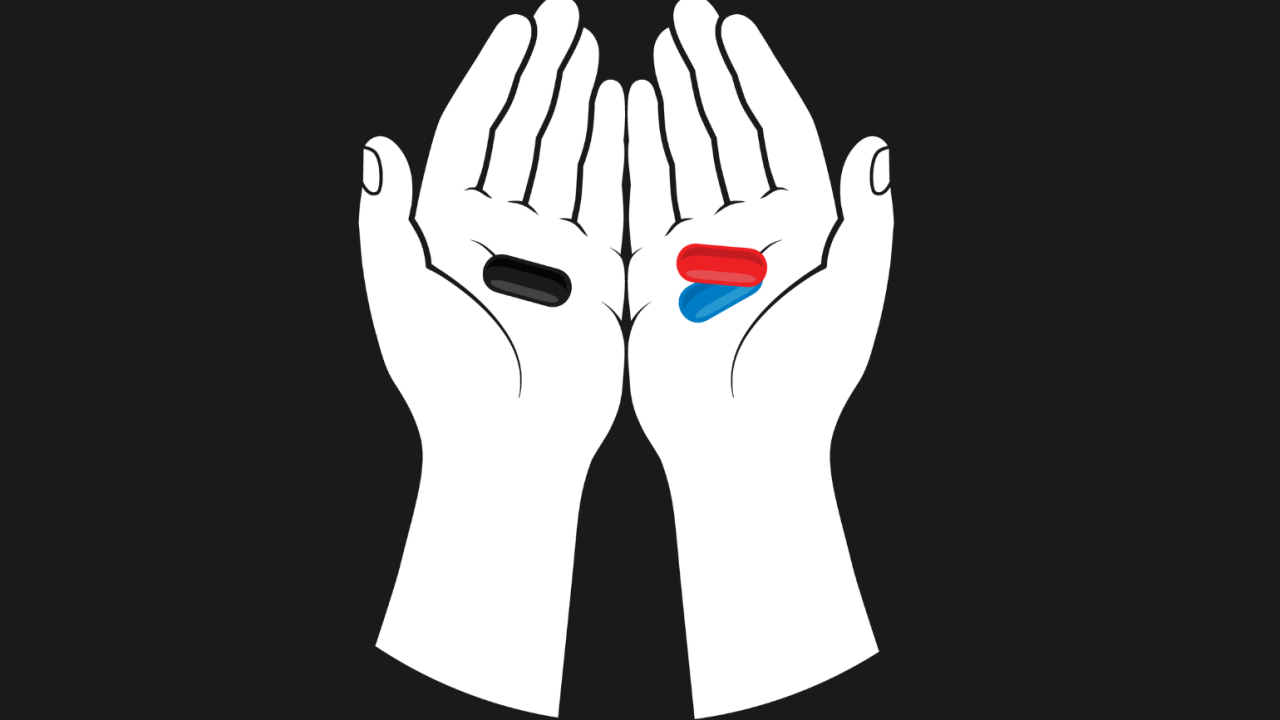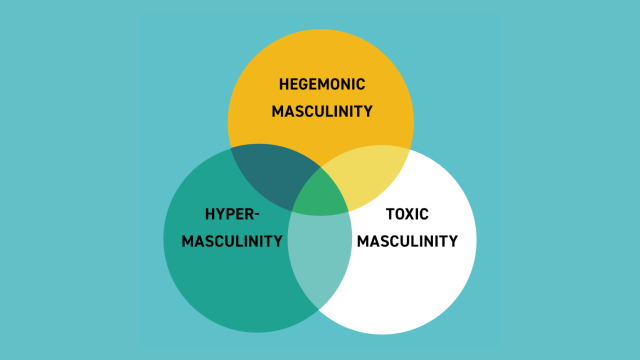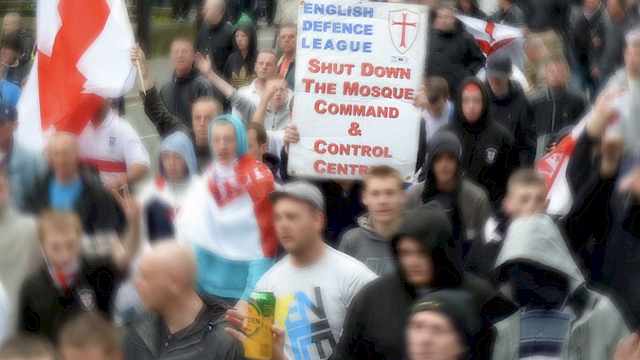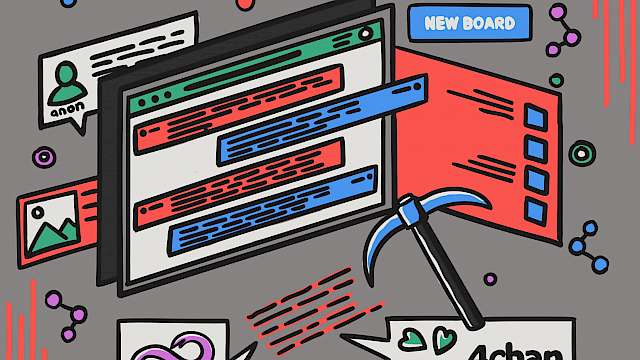At around 1800 local time on 12th August 2021, a man carried out a spree killing in Plymouth, UK, that resulted in the deaths of five people, before ultimately taking his own life. The perpetrator, Jake Davison, was an active member in online spaces hosting incel content. In 2020, two UK teenagers who also engaged with the online incel community to some degree, faced trial for possessing terrorism-related materials.
Inevitably, these and other cases have sparked discussions in the UK regarding whether the incel ideology should be considered an extremist one, and whether those who are motived by its ideas to carry out acts of violence should be considered terrorists. The UK is not alone in this debate; Canada, for instance, listed Inceldom as a violent extremist ideology in 2019. The existence of these discussions is testament to the way in which the incel subculture and worldview is amorphous in nature, which makes it hard for researchers and practitioners to frame this worldview, and those who subscribe to it, in the traditional language of terrorism and counter-terrorism. The issue is exacerbated by the way in which ideas that are now associated with the ‘incel’ label have motived other forms of violence that do not constitute an act of mass-violence. For instance, a series of stabbings in Portsmouth, UK, in June-July 2014 resulted in the serious injury of three women, with the perpetrator stating in a letter to the police that "I am still a virgin, everyone is losing it before me, that's why you are my chosen target.", and further notes including misogynistic language and detailing a perceived need for revenge against women for his lack of sexual relationships.
An extremist ideology?
Most researchers analysing incel online communities agree that discussions taking place on these digital spaces contain highly problematic language. Some studies have argued that the incel subculture exhibits all of the characteristics of an extremist ideology (Baele, Brace and Coan, 2019; Jaki et al., 2019), structured by an opposition between an in-group and harmful out-group(s), with intergroup competition being presented in the form of a crisis-solution narrative (see Berger, 2018a, 2018b). It has been shown that the incel in-group/out-group(s) crisis narrative consists of a three-tiered hierarchy, where a minority of ‘Alpha’ males (‘Chads’) and females (‘Stacys’) stand on top, a majority of average-looking ‘Betas’ (‘normies’) follow, and a minority exclusively male and unattractive incels are stuck at the bottom, constantly oppressed and victims of relentless discrimination and harassment. The out-groups are discussed in relation to perceived negative traits, such as women being only capable of simple emotions (chiefly sexual desire) and having the tendency to cheat on their partners and manipulate men for sex or money. This three-tier hierarchy highlights the contradictory nature of the incel worldview, in that it places the incels themselves at the bottom of this social hierarchy and argues that they are oppressed by women who withhold sex from them, whilst also arguing that incels are superior to the out-groups due to their perceived intellectual superiority; what they refer to as ‘high IQ’ (van Brunt and Taylor, 2021).
The black pill concept is often discussed in relation to suicide within incel online spaces due to the extreme nihilism associated with it.
The ‘black pill’ concept asserts that this hierarchy not only exists, but that its categories – and ensuing discrimination against incels – are so immutable that nothing can be done to move from one social category to another; i.e., to move from being an incel to a ‘normie’ (Ging, 2019; Hoffman, Ware and Shapiro, 2020). The black pill concept is often discussed in relation to suicide within incel online spaces due to the extreme nihilism associated with it. Due to narratives such as this, some researchers have shown that incel spaces have similar levels of ‘toxicity of discussion’ as far-right platforms (Ribeiro et al., 2020).
Yet recent studies have highlighted that not all incels condone violence (Moskalenko et al., 2022), and that a lot of incel content exhibits typical anxieties of young men transitioning to adults (O’Malley, Holt and Holt, 2020). We also know that discussions in radical online communities are usually driven by a small minority of influential contributors (Scrivens et al., 2021; Baele et al., 2022), and that extremist online ecosystems are usually heterogenous in the views they host. As a result, any diagnosis of incel ‘extremism’ and its link with offline violence ought to rest on a detailed and multifaceted assessment of the whole community and be attuned to variations across time and individuals.
Towards a nuanced assessment
To gain such a nuanced assessment, it is fruitful to adopt an ‘ecosystem’ approach to studying extremist online spaces (Baele, Brace and Coan, 2020; Hutchinson et al., 2022). From that perspective, the online spaces hosting incel content – such as sub-Reddits, forums, Telegram channels, or Instagram accounts – ought to be understood together as a dynamic network or interacting units, and can be collectively referred to as the ‘incelosphere’. A study using computational methods to both collect and analyse all text data, and accompanying metadata, from all these sites (33 different online spaces covering the period 2013-2022, yielding a dataset consisting of 11,717,516 posts). allowed for an evaluation of how extreme the content and discussions on these platforms have been over time. To evaluate the proportion of violent language in this content, we used a custom ‘dictionary’ or lexicon, named the ‘Incel Violent Extremism Dictionary’ (IVED), containing three types of words found in the corpus; dehumanising out-group nouns, violent verbs, and nouns related to weapons (Baele, Brace and Ging, 2023).
This analysis revealed that the incelosphere is not homogenous in terms of the amount of violent extremist language that features on each of the online spaces. The dedicated incel forums indeed host a greater proportion of extreme and violent words than sub-Reddits and chan boards (figure 1). However, at the same time, the analysis also demonstrated a worrying trend: there is a clear temporal evolution whereby, not only did the early three major incel online space (the sub-Reddits r/Incel, r/Incels, and r/Braincels) geot progressively more extreme in their conversations over time, but this growing intensification of extremist language continues to this day at the ecosystem-level, with the main incel forum, Incels.is, demonstrating the highest ratios of violent language to date (figure 2). This is coupled with an analysis of the number of daily posts made to each online space, which demonstrated that Incels.is has also been acting as the long-standing centre point of the incelosphere since the closure of r/Braincels.

Figure 1: Correspondence analysis of incel online spaces’ lexical proximity with violent extremist language (IVED) and most common incel words. From Baele, Brace and Ging (2023).
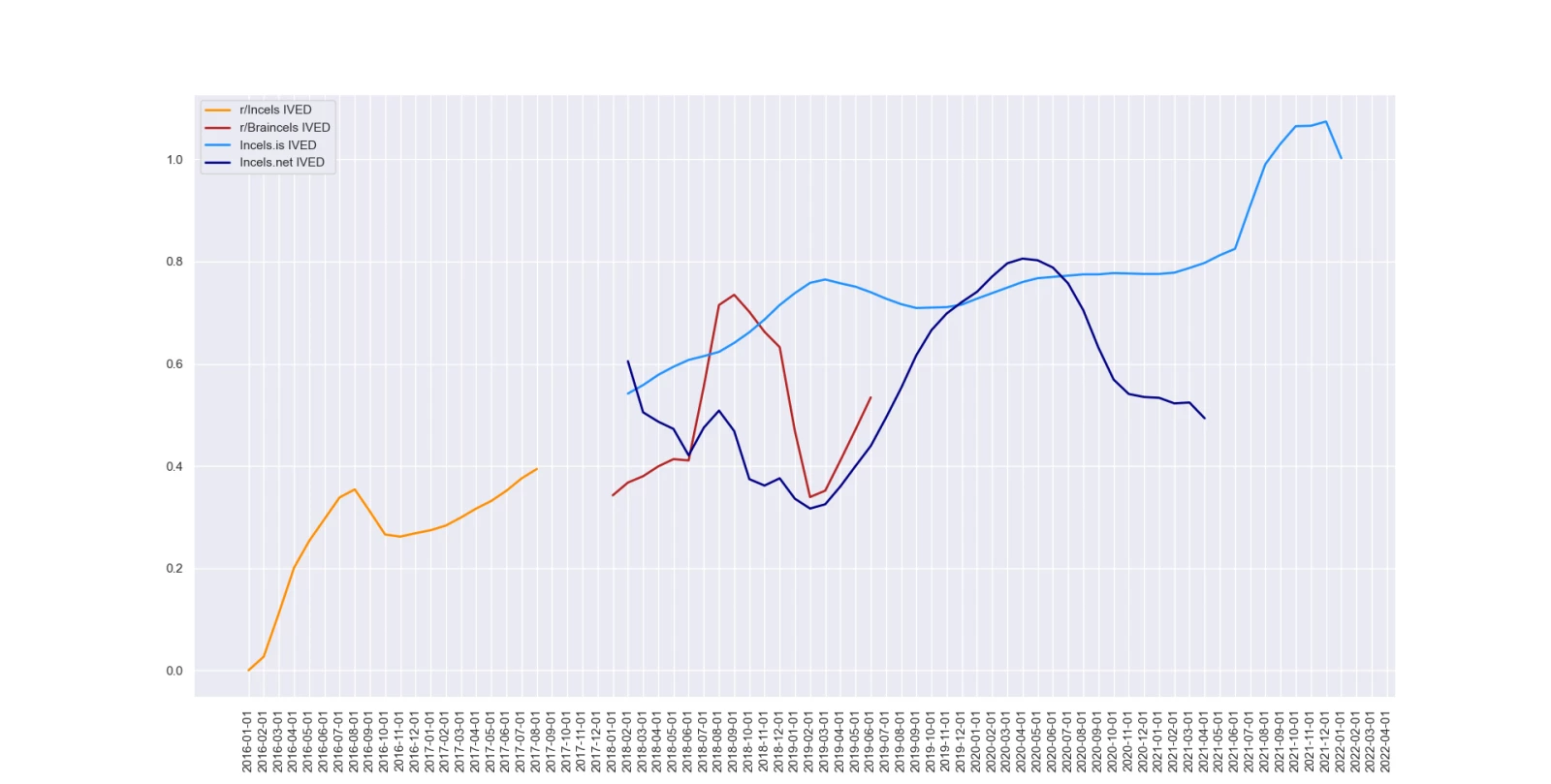
Figure 2: Time series trend data for /r/Incels, /r/Braincels, Incels.is, and Incels.net, plotted as a 3-month rolling average. From Baele, Brace and Ging (2023).
the incel tendency towards mass violence could be conceptualised as a red pill-to-black pill pipeline.
While empirical evidence has shown that the incel community mostly does not view acts of incel-inspired violence as a way of bringing around some form of social-political change, but instead view such acts as a form of personal revenge or cathartic release for the perpetrator (Baele, Brace and Coan, 2019; Brace, 2021), it is theoretically possible that the incel tendency towards mass violence could be conceptualised as a red pill-to-black pill pipeline. Given what is known about the demographics of the userbase (Sugiura, 2021; Williams et al., 2021), it is possible that some of the younger individuals (i.e., 12-13) are engaging with this content but naturally disengaging from it as they gain life experience, resulting in their time on these online spaces being a temporary phase. However, those who do not form meaningful social relationships and instead continue to interpret their offline, real-world, experiences through the black pill ideology develop increasingly nihilistic views as they progress throughout their teenage years, which combined with the aspects of ideology described above, could increase their tendency towards violence and suicidal ideation. This might explain why a sense of hopelessness and suicidal ideation have been noted in most incel attackers (van Brunt and Taylor, 2021; Williams et al., 2021) and why so many of them either commit suicide at the end of their attack or attempt ‘suicide by cop’.
However, such psychological traits alone would not be sufficient in themselves to motivate an individual to carry out an act of mass violence, with research indicating that they need to be accompanied by the kind of over-generalisations, victim dehumanisation and neutralisation, and justifications seen in the incel ideology (van Brunt and Taylor, 2021; Williams et al., 2021; Broyd et al., 2022). Given the purely online nature of the incel subculture, it therefore becomes crucial to understand the nature of incel online spaces in relation to extremist discussions. We have seen here that the incelosphere’s violent and extremist language is not homogenous and that it has increased over time. Future work should therefore focus on understanding these changes in online discussions on the incelsophere within the context of how individuals might use them as a lens through which to perceive their real-world, offline, interactions; a concept that scholars refer to as ‘onlife’ (Valentini, Lorusso and Stephan, 2020).
Summary:
Much work remains to be done in developing an understanding of incels and the tendency towards violence. While the sample size of known incel attackers is currently, and fortunately, still quite small, analysis of their behaviours and psychological traits combined with the kind of data-driven work summarised here indicates the need to develop a nuanced understanding of the relationship between online discussions of offline push and pull factors as a motivator towards violence.
The full analysis that is summarised above can be found in Baele, S., Brace, L., & Ging, D. (2023) A Diachronic Cross-Platforms Analysis of Violent Extremist Language in the Incel Online Ecosystem, Terrorism and Political Violence https://doi.org/10.1080/09546553.2022.2161373
This work was supported by the Economic and Social Research Council under Grant ES/V002775/1.
Read more
Baele, S., Brace, L. and Ging, D. (2023) ‘A Diachronic Cross-Platforms Analysis of Violent Extremist Language in the Incel Online Ecosystem’, Terrorism and Political Violence, pp. 1–24. Available at: https://doi.org/10.1080/09546553.2022.2161373.
Baele, S.J. et al. (2022) ‘Super- (and hyper-) posters on extremist forums’, Journal of Policing, Intelligence and Counter Terrorism, pp. 1–39. Available at: https://doi.org/10.1080/18335330.2022.2103386.
Baele, S.J., Brace, L. and Coan, T.G. (2019) ‘From “Incel” to “Saint”: Analyzing the violent worldview behind the 2018 Toronto attack’, Terrorism and Political Violence, 33(8), pp. 1667–1691. Available at: https://doi.org/10.1080/09546553.2019.1638256.
Baele, S.J., Brace, L. and Coan, T.G. (2020) ‘Uncovering the Far-Right Online Ecosystem: An Analytical Framework and Research Agenda’, Studies in Conflict & Terrorism, pp. 1–21. Available at: https://doi.org/10.1080/1057610X.2020.1862895.
Berger, J.M. (2018a) Extremism. The MIT Press. Available at: https://doi.org/10.7551/mitpress/11688.001.0001.
Berger, J.M. (2018b) ‘The Difference between a Killer and a Terrorist’, The Atlantic. Available at: https://www.theatlantic.com/politics/archive/2018/04/the-difference-between-killer-and-terrorist/558998/.
Brace, L. (2021) A Short Introduction To The Involuntary Celibate Sub-Culture. Available at: https://crestresearch.ac.uk/resources/a-short-introduction-to-the-involuntary-celibate-sub-culture/ (Accessed: 10 July 2022).
Broyd, J. et al. (2022) ‘Incels, violence and mental disorder: a narrative review with recommendations for best practice in risk assessment and clinical intervention’, BJPsych Advances, pp. 1–11. Available at: https://doi.org/10.1192/bja.2022.15.
van Brunt, B. and Taylor, C. (2021) Understanding and Treating Incels: Case Studies, Guidance, and Treatment of Violence Risk in the Involuntary Celibate Community. Abingdon: Routledge.
Ging, D. (2019) ‘Alphas, Betas, and Incels: Theorizing the Masculinities of the Manosphere’, Men and Masculinities, 22(4), pp. 638–657. Available at: https://doi.org/10.1177/1097184X17706401.
Hoffman, B., Ware, J. and Shapiro, E. (2020) ‘Assessing the Threat of Incel Violence’, Studies in Conflict & Terrorism, 43(7), pp. 565–587. Available at: https://doi.org/10.1080/1057610X.2020.1751459.
Hutchinson, J. et al. (2022) Violent Extremist & REMVE Online Ecosystems: Ecological Characteristics for Future Research & Conceptualization. RESOLVE Network. Available at: https://doi.org/10.37805/remve2022.5.
Jaki, S. et al. (2019) ‘Online hatred of women in the Incels.me forum: Linguistic analysis and automatic detection’, Journal of Language Aggression and Conflict, 7(2), pp. 240–268. Available at: https://doi.org/10.1075/jlac.00026.jak.
Moskalenko, S. et al. (2022) ‘Predictors of Radical Intentions among Incels: A Survey of 54 Self-identified Incels’, Journal of Online Trust and Safety, 1(3). Available at: https://doi.org/10.54501/jots.v1i3.57.
O’Malley, R.L., Holt, K. and Holt, T.J. (2020) ‘An Exploration of the Involuntary Celibate (Incel) Subculture Online’, Journal of Interpersonal Violence, p. 088626052095962. Available at: https://doi.org/10.1177/0886260520959625.
Ribeiro, M.H. et al. (2020) ‘The Evolution of the Manosphere Across the Web’, arXiv:2001.07600 [cs] [Preprint]. Available at: http://arxiv.org/abs/2001.07600 (Accessed: 3 February 2022).
Scrivens, R. et al. (2021) ‘Examining Online Indicators of Extremism in Violent Right-Wing Extremist Forums’, Studies in Conflict & Terrorism, pp. 1–25. Available at: https://doi.org/10.1080/1057610X.2021.1913818.
Sugiura, L. (2021) The Incel Rebellion: The Rise of the Manosphere and the Virtual War Against Women. Bingley: Emerald Publishing Limited.
Valentini, D., Lorusso, A.M. and Stephan, A. (2020) ‘Onlife Extremism: Dynamic Integration of Digital and Physical Spaces in Radicalization’, Frontiers in Psychology, 11, p. 524. Available at: https://doi.org/10.3389/fpsyg.2020.00524.
Williams, D.J. et al. (2021) ‘Wanting sex and willing to kill: Examining demographic and cognitive characteristics of violent “involuntary celibates”’, Behavioral Sciences & the Law, 39(4), pp. 386–401. Available at: https://doi.org/10.1002/bsl.2512.
Copyright Information
Image credit: © archivector | stock.adobe.com
